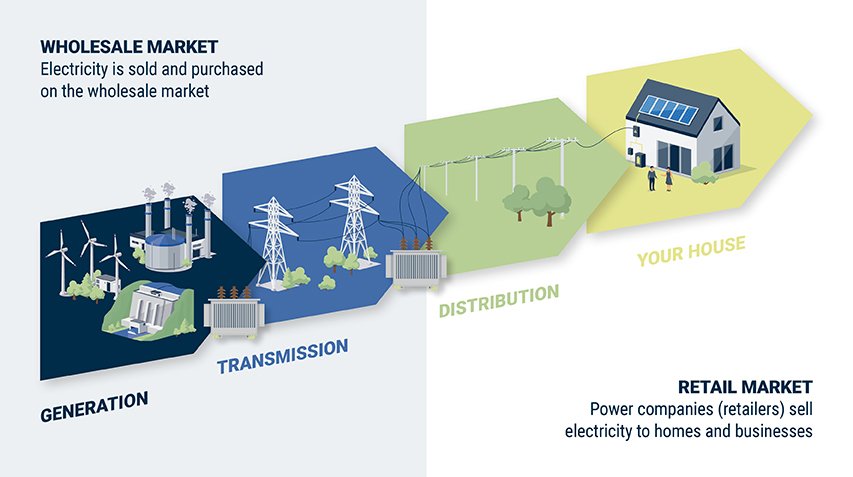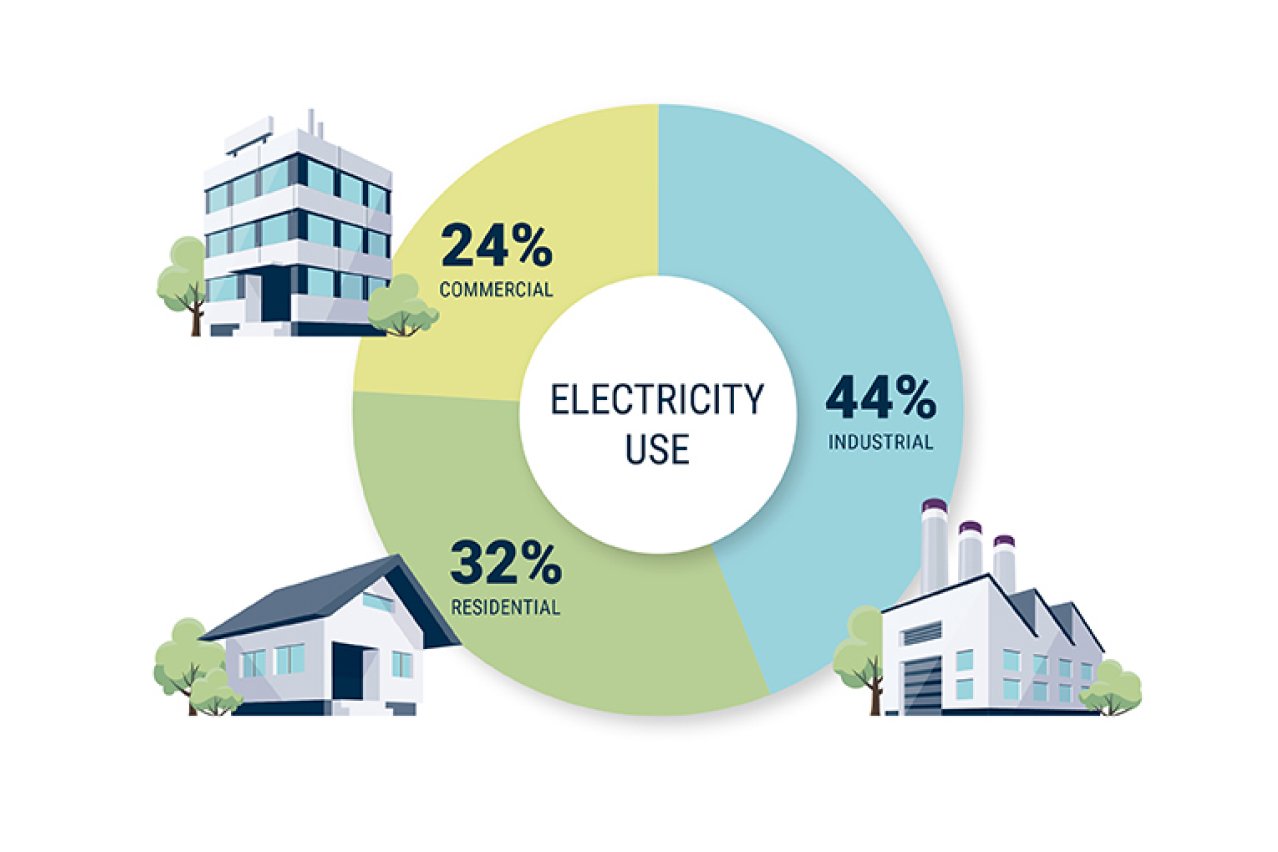New Zealand's electricity sector
Supplying electricity to homes and businesses across New Zealand involves three key elements: generating electricity, transporting electricity to distribution companies, and then selling it to customers.

Generation
Generation companies generate electricity at power stations and inject electricity into transmission lines (grid-connected generation) or distribution lines (embedded generation). Lots of companies generate power, but the majority is generated by four companies: Contact Energy, Genesis Energy, Meridian Energy and Mercury Energy.
The electricity generated is sold via the wholesale or spot market to retailers and large industrial users. Buyers purchase electricity every 30 minutes via auctions. They must pay the electricity spot price, which changes every auction to reflect underlying market conditions.
There are about 80 generation companies, 62 retailers and four gentailers (generator-retailers) in New Zealand's wholesale market. The remaining wholesale market participants comprise distribution and network companies and traders in secondary markets, such as financial hedges.
The spot and hedge markets are the major components of the wholesale market. Prices on the spot market are calculated every half-hour and vary depending on supply and demand and the location on the national grid.
In addition to buying electricity directly from the spot market, retailers and large industrial users can also enter into financial contracts (hedges), which smooth out some or all of the volatility in spot prices. Hedges protect buyers against volatile spot priced by fixing their electricity price for a specified period. Also, some generators can sell their output via hedge contracts, insulating them against the risk of low spot prices.
Generation investment dashboard
The data on current and expected new renewable electricity generation projects in New Zealand.
Energy margin dashboard
The energy margins the New Zealand generators are making when selling into the wholesale electricity market.
Transmission
The transmission system or national grid transports electricity at high‑voltage from power stations, where it is generated, to large industrial users and local substations. The electricity is then delivered by lines companies (also called distributors or network companies) through local networks to homes and businesses.
The grid is made up of over 11,000 kilometres of high‑voltage transmission lines, 25,000 pylons that hold them, and 170 substations.
Electricity is transported at high voltage (up to 220,000 volts) through a high‑voltage alternating current system around New Zealand. To transfer electricity between the North and South Island, there is a high‑voltage direct current (HVDC) inter‑island cable with a transmission line under the Cook Strait. Electricity generated in the South Island is often transported north via the HVDC cable, as the North Island has higher electricity demand.
The grid is owned, operated, maintained and developed by Transpower, a state-owned enterprise. Transpower's national grid operating centres operate the grid in real time to ensure generation matches demand, in accordance with the rules of the electricity market. They charge a fee to the lines companies for use of the transmission network. These fees are regulated by the Commerce Commission. Lines companies pass on the transmission fee to retailers.

Distribution
Lines companies (distribution companies) provide and maintain 150,000 kilometres of power lines that carry electricity via power poles and lines from the national transmission grid to homes and businesses across New Zealand.
Lines companies ensure their customers receive their electricity at a particular level of quality and reliability. This includes keeping a certain amount of additional capacity available on the networks for each customer to use.
There are 29 lines companies which own the networks that transport electricity. Lines companies are mostly owned by consumer trusts or local councils, but some are privately owned.
Retail
Retail companies buy electricity from generators and on-sell that electricity to businesses and households across New Zealand.
For most New Zealand electricity customers, there are a lot of retailers and brands to buy electricity from. Each retailer sets its own prices. You can choose the best combination of price, product and service that suits your needs. See if you can save, by using Powerswitch it's a free, independent energy-price comparison service.
Consumption
There are nearly two million electricity consumers in Aotearoa, from typical households which consume about 7MWh per year to the Tiwai Point aluminium smelter which consumes about 570MW per year (about one third of the total electricity consumed in the South Island and 13% of the total electricity nationwide).

How is New Zealand's electricity system changing?
New Zealand's electricity system is transforming to electrify New Zealand and reach net zero carbon emissions for 2050. The electricity market is shifting to more renewable intermittent generation (eg, wind and solar), with new and many technological advancements, distributed energy resources (eg, rooftop solar panels and battery storage), mass participation and two-way power flows.
Electricity demand is expected to increase by up to 82% by 2050 (baseline 2013). The future will see consumers have more control over their electricity use; widespread use of electric vehicles, battery storage and smart chargers to help stabilise the grid; and communities that are increasingly resilient in the face of significant weather events and natural disasters.
As New Zealand’s electricity regulator, the changes occurring require proactive and fit-for-purpose regulation so consumers can reap the benefits of innovation and competition at least cost, while receiving a reliable electricity supply. We have a multi-year plan to improve security of supply, investment and innovation, with a focus on boosting competition and efficiency in the electricity market to put downward pressure on prices and increase affordability for consumers.